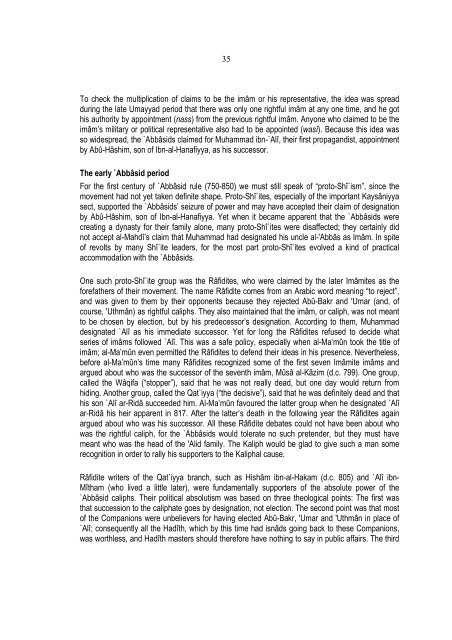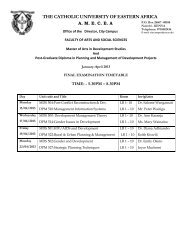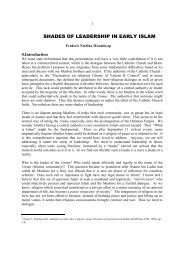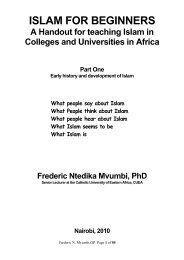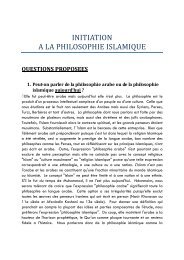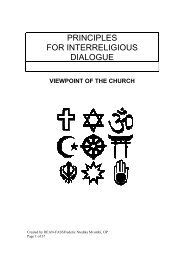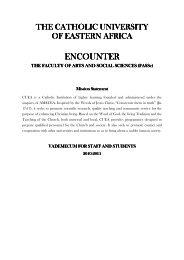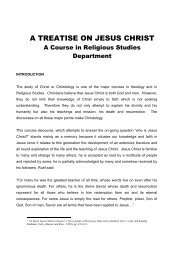INTRODUCTION TO ISLAMIC THEOLOGY.pdf - CUEA
INTRODUCTION TO ISLAMIC THEOLOGY.pdf - CUEA
INTRODUCTION TO ISLAMIC THEOLOGY.pdf - CUEA
You also want an ePaper? Increase the reach of your titles
YUMPU automatically turns print PDFs into web optimized ePapers that Google loves.
35To check the multiplication of claims to be the imâm or his representative, the idea was spreadduring the late Umayyad period that there was only one rightful imâm at any one time, and he gothis authority by appointment (nass) from the previous rightful imâm. Anyone who claimed to be theimâm’s military or political representative also had to be appointed (wasî). Because this idea wasso widespread, the `Abbâsids claimed for Muhammad ibn-`Alî, their first propagandist, appointmentby Abû-Hâshim, son of Ibn-al-Hanafiyya, as his successor.The early `Abbâsid periodFor the first century of `Abbâsid rule (750-850) we must still speak of “proto-Shî`ism”, since themovement had not yet taken definite shape. Proto-Shî`ites, especially of the important Kaysâniyyasect, supported the `Abbâsids’ seizure of power and may have accepted their claim of designationby Abû-Hâshim, son of Ibn-al-Hanafiyya. Yet when it became apparent that the `Abbâsids werecreating a dynasty for their family alone, many proto-Shî`ites were disaffected; they certainly didnot accept al-Mahdî’s claim that Muhammad had designated his uncle al-'Abbâs as Imâm. In spiteof revolts by many Shî`ite leaders, for the most part proto-Shî`ites evolved a kind of practicalaccommodation with the `Abbâsids.One such proto-Shî`ite group was the Râfidites, who were claimed by the later Imâmites as theforefathers of their movement. The name Râfidite comes from an Arabic word meaning “to reject”,and was given to them by their opponents because they rejected Abû-Bakr and 'Umar (and, ofcourse, 'Uthmân) as rightful caliphs. They also maintained that the imâm, or caliph, was not meantto be chosen by election, but by his predecessor’s designation. According to them, Muhammaddesignated `Alî as his immediate successor. Yet for long the Râfidites refused to decide whatseries of imâms followed `Alî. This was a safe policy, especially when al-Ma’mûn took the title ofimâm; al-Ma’mûn even permitted the Râfidites to defend their ideas in his presence. Nevertheless,before al-Ma’mûn’s time many Râfidites recognized some of the first seven Imâmite imâms andargued about who was the successor of the seventh imâm, Mûsâ al-Kâzim (d.c. 799). One group,called the Wâqifa (“stopper”), said that he was not really dead, but one day would return fromhiding. Another group, called the Qat`iyya (“the decisive”), said that he was definitely dead and thathis son `Alî ar-Ridâ succeeded him. Al-Ma’mûn favoured the latter group when he designated `Alîar-Ridâ his heir apparent in 817. After the latter’s death in the following year the Râfidites againargued about who was his successor. All these Râfidite debates could not have been about whowas the rightful caliph, for the `Abbâsids would tolerate no such pretender, but they must havemeant who was the head of the 'Alid family. The Kaliph would be glad to give such a man somerecognition in order to rally his supporters to the Kaliphal cause.Râfidite writers of the Qat`iyya branch, such as Hishâm ibn-al-Hakam (d.c. 805) and `Alî ibn-Mîtham (who lived a little later), were fundamentally supporters of the absolute power of the`Abbâsid caliphs. Their political absolutism was based on three theological points: The first wasthat succession to the caliphate goes by designation, not election. The second point was that mostof the Companions were unbelievers for having elected Abû-Bakr, 'Umar and 'Uthmân in place of`Alî; consequently all the Hadîth, which by this time had isnâds going back to these Companions,was worthless, and Hadîth masters should therefore have nothing to say in public affairs. The third


